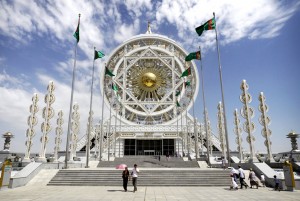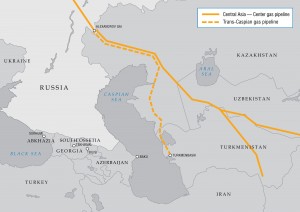The US and NATO are set to withdraw the majority of their forces from Afghanistan by year’s end (or perhaps be forced to remove them all, leaving the unprepared Afghan authorities to deal with the Taliban terrorist insurgency and a possible government collapse. This isn’t an unintended aftereffect of over a decade of war and occupation – it’s now the primary strategic objective. Since Turkmen resources could not be secured and transferred to the West via the Indian Ocean, instead going to Russia, China, Iran (RCI), and possibly to Pakistan and India, the US is now focusing on a major resource-denial attack directed against these clients via post-withdraw Turkmen destabilization. It also understands that the country is the lynchpin bringing together RCI interest in Central Asia, thereby meaning that it can attack all three of them by proxy through its territory. Turkmenistan is highly vulnerable to America’s destabilization attempts, and besides disrupting valuable energy flows to its neighbors, a major consequence would be the emergence of a Black Hole of Chaos in the heart of Eurasia.
The US’ Strategic Imperative
Though many may be confused about why the US would want to wreck the region after spending a decade and trillions of dollars on trying to ‘stabilize’ it, the explanation is rather simple. Among other reasons, one of the most important motives for the Afghan War was to facilitate the transit of Turkmen energy to Western markets. When this failed, Brzezinski’s Eurasian Balkans concept was decided upon in order to tear the Heartland apart and prevent the US’ Eurasian rivals from accessing Turkmenistan’s gluttonous gas reserves. Another dual purpose of ripping the region apart is to create a domino destabilization that can carry the consequent secessionist spiral and terrorist tide over into the rest of Central Asia and then further afield to RCI.
All Eurasian Roads Lead to Turkmenistan

Turkmenistan is geostrategically unique in the sense that RCI, the resistant and defiant Eurasian Powers, are all intimately connected with it and have serious security concerns that would be adversely affected by any destabilization there. This deserves to be examined further in order to understand its full gravity.
Russia:
Moscow is first and foremost concerned about any spread or enablement of terrorism near its borders or those of the recently christened Eurasian Union. Due to Russia’s integration with Kazakhstan and that country’s easily penetrable border with Turkmenistan, any chaos that breaks out there can rapidly spread north and eventually reach Russia. Also, Turkmenistan is located very close to Zhanaozen in Kazakhstan, whose late-2011 riots had the potential to destabilize the entire country. Moreover, chaos could spread eastward and consume the rest of Central Asia from what has up until now been an unexpected vector of destabilization, thereby making the affected parties all the more vulnerable.
China:
China’s primary interest in Turkmenistan is its enormous gas reserves, and both countries have a very close relationship in this field as a result of the Central Asia-China gas pipeline. China Daily reports that China is Turkmenistan’s largest customer of natural gas (supplied by the world’s second-largest gas field) and that Turkmenistan is China’s largest supplier of this resource. The pipeline in focus extends across the region and links with Xinjiang, which has seen US-sponsored extreme Islamic and nationalist destabilization in recent years.
Whereas the centralized Chinese state may have initially thought that the similarly governed countries of Central Asia represented an oasis of stability, the expansion of Afghan anarchy can quickly make them reconsider their initial calculations. In the event of Turkmen and subsequent regional chaos, the pipeline becomes an enticing and exposed target in the middle of the desert, and a disruption of supplies would not only affect China proper, but could contribute to further destabilization in Xinjiang, the endpoint of the pipeline. Also, a wide-scale breakdown of order in Xinjiang’s Central Asian neighborhood could create a nearby terrorist haven for Uighur militants that could later re-infiltrate back into China to carry out attacks.
Iran:
Concerning Iran, a collapse of the Turkmen state would complete the noose of threats that the US has managed to create all around the state. The desert border with Turkmenistan is quite permeable, and armed groups and weapons flows there could pose a serious threat to internal Iranian security. Going clockwise from here, the threat from the Taliban in Afghanistan is obvious, and Balochistan separatism can become a convenient US-supervised flare up between Iran and Pakistan if the two continue moving towards closer energy cooperation. The Gulf Kingdoms are militarized to the teeth with American weaponry to combat Iran, with the Saudis reaching a long-term $60 billion arms deal in 2010 and the Qataris clinching an $11 billion one this year.
ISIL is threatening Iran in the west and could possibly entrap it in a quagmire in Iraq, and an independent Kurdistan can aid its Iranian brethren in rising up and fighting a ‘liberation’ war against Tehran. Turkey’s NATO affiliation means that it can join any Western war against Iran through obligation (either actively/directly or passively/indirectly), thus remaining a neighbor that can never be fully trusted. Finally, Azerbaijan could promote separatism among the ethnic Azeris in the north of Iran that constitute nearly a quarter of the country’s total population, to say nothing of its suspected hosting of Israeli drone bases.
Iran is thus faced with a plethora of existential threats on its borders, including ISIL, the Kurds, and the Taliban, which could all spill their chaos into the country. Therefore, if Turkmenistan were to meltdown and become a haven for similar non-state actors to attack Iran, this may be the straw that breaks the camel’s back, and Tehran would have intense difficulty dealing with so many expansionist threats simultaneously. This would thereby increase the chance for a strategic slipup that could open the floodgates for an internal war and concurrently make Iran even more vulnerable to an outside state-directed attack.

The Sitting Duck
After having extrapolated upon the importance of Turkmenistan for RCI, it is now time to transition towards speaking about its two inherent vulnerabilities that make it a prime target for destabilization after the 2014 NATO drawdown in Afghanistan.
The first vulnerability is Turkmenistan’s physical and social geography. The vast majority of the country is a desert with scare population density. Most of the people are concentrated in the capital of Ashgabat or a few other scattered cities, all of which are along or in close proximity to rivers or canals. Superimposing the lessons being learned from ISIL’s campaign in Syria and Iraq, Turkmenistan has the same geographic characteristics that enable militant transnational non-state actors (in this case, likely the Taliban or an offshoot thereof) to expand their reach throughout a large segment of loosely administered territory.
The other vulnerability is even more significant, since it demonstrates how Turkmenistan has but a faint chance at repelling any non-state actor destabilization streaming into its borders from Afghanistan. The problem is the country’s official and extreme neutrality, which although originally intended to safeguard it from conventional state threats in an unstable region during an uncertain transitional time, has now resulted in the unintended consequence 19 years later of neutralizing any defensive assistance Turkmenistan could receive from other states in combating non-state dangers. It has not participated in any joint military exercises and has no experience of joint interoperability with other armed forces, nor is it within the CSTO and SCO frameworks. Importantly, it also has no combat experience whatsoever besides repelling the increasingly frequent Taliban incursions into its territory that have occurred over the past few years.
These two vulnerabilities combine to make Turkmenistan a sitting duck that is exceptionally susceptible to an ISIL-like offensive. Should the Taliban follow the lead of their spiritual brothers in the Mideast, they could capture American armor and vehicles from Afghan security forces and turn them towards Turkmenistan, just as ISIL has done against Syria with US equipment seized in Iraq. The Taliban probably already have an extensive stockpile of American arms as it is, considering that 40% of weapons the US has sold to the Afghan government cannot be accounted for. Therefore, if the Taliban follow the ISIL model of combining conventional and asymmetric tactics during their regional campaign, they could easily sweep across the Turkmen countryside and the unprepared government would be almost powerless to stop it, nor would they be able to rely on outside CSTO or SCO assistance in pre-empting this threat or dealing with it once it materializes. If the Taliban turn out to be as lightning quick and effective as ISIL is, then the Turkmen state could crumble as quickly as Iraq and bring about the US’ intended Black Hole of Chaos.
Concluding Thoughts
As has been argued, Turkmenistan is overripe for a Taliban destabilization after the 2014 NATO drawdown in Afghanistan. Just like the US shepherds ISIL from afar to carry out its strategic objectives in the Mideast, so too is it anticipated to do this for the Taliban in Central Asia. Although having failed in its original goal of securing an energy conduit to the Indian Ocean, the US is now intent on achieving its fallback plan of a major resource-denial attack and proxy destabilization against Russia/China/India (RCI), using the Taliban as ‘convenient fools’ in bringing this about. Turkmenistan’s geopolitical peculiarities make it an important security concern for RCI, and its geographic and institutional vulnerabilities make it an overwhelmingly tempting target for the US to ‘kill three birds with one stone’ and destabilize all three Eurasian Powers in one strategic stroke.














Pingback: Turkmenistan as the Three-for-One Staging Ground of Eurasian Destabilization | No War in Europe - Russia is NOT our Enemy!
Pingback: Chaosistan - Occurrences
Pingback: Uzbekistan’s Bubbling Pot of Destabilization | Oriental Review
Pingback: Uzbekistan’s Bubbling Pot of Destabilization | TAR News
Pingback: The Case For Bringing Syria Into The SCO | Oriental Review
Pingback: The Case for Bringing Syria Into the Shanghai Cooperation Organization (SCO) | Counter Information
Pingback: The Case For Bringing Syria Into The Shanghai Cooperation Organisation (SCO) | EMerging Equity
Pingback: Uzbekistan: U.S. Policy and the Changing Security Landscape of Central Asia (Part One) | Foreign Intrigue
Pingback: The US is juggling chaos and coordination in order to contain China | Oriental Review
Pingback: The US Is Juggling Chaos And Coordination In Order To Contain China | PushBack.US
Pingback: The U.S. Is Juggling Chaos And Coordination In Order To Contain China – OpEd | EMerging Equity
Pingback: The Hoagland-Blinken Doctrine Is Washington’s Updated Plan For Central Asia (II) | Oriental Review
Pingback: Les USA jonglent entre chaos et coordination pour contenir la Chine | Arrêt sur Info
Pingback: The Hoagland-Blinken Doctrine Is Washington’s Updated Plan For Central Asia (II) |
Pingback: Les USA jonglent entre chaos et coordination face à la Chine
Pingback: Riyadh’s Geopolitical Designs. Expanding Saudi Arabia’s Sphere of Influence? | Counter Information
Pingback: 2016 Trends and Geopolitical Forecast: Mega Analysis of Europe, Eurasia and the Middle East | Counter Information
Pingback: 2016 Trends And Geopolitical Forecast: Mega Analysis Of Europe, Eurasia, And The Middle East | FXandGeopolitix
Pingback: Mega analysis: 2016 Trends Forecast by Andrew Korybko - GPOLIT
Pingback: Uzbekistan: Security, Human Rights, Separatism and Geopolitics (Complete Series) | Foreign Intrigue